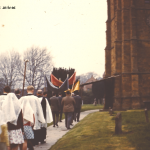Near the wall of the churchyard adjacent to the HSBC bank, roughly equidistant from the gate and the church door, is a stone which commemorates Charles Parsons. He died in 1803 aged 68, “for many years Preacher of the Gospel at Little Kineton Chapel”. If you catch it in the right light, it is easy to read (though on a dull day almost illegible).
Amazingly, Charles Parsons provides a tenuous link between William Wilberforce and Kineton vicar (William Talbot vicar from 1717 until 1774), and the Independent Chapel in Little Kineton. The chapel was pulled down in the 1980s, and nothing remains of it except, possibly, the iron gate in the railings at the entrance to Norton Grange. Once, it is reputed, this led to their old burial ground.
Charles is said to have had a dramatic conversion to Christianity.
“He would make mention of to his friends, that when a farmer’s servant, and but a boy, he was melted down, while at his work in the fields, under a sense of the love of God in sending his son into the world to save sinners. These reflections led him to retire under the branches of a spreading tree, and pour out his soul to God in prayer…”
He spent the first half of his life as a servant, first with William Talbot, the evangelical vicar of Kineton who was here from 1717 to 1774, and then with William Wilberforce, uncle of the campaigner for the abolition of the slave trade. While with the Wilberforce family he helped conduct their daily worship and Mrs Wilberforce is quoted as prophesying “Charles, when I am dead, you will go into your own country and preach the gospel to the poor.”
That prophesy came true in 1780 when Charles was 55. The vicar who followed William Talbot was “inimical to evangelical doctrine”, and led the parish away from the informal style of services that Talbot had introduced. Some of the congregation were unhappy with the way things were going, so they invited Charles Parsons back to Kineton to preach to them. His services were so popular that he was persuaded to return to live in the village.
During the 1790s a chapel was built at Little Kineton in which he preached twice every Sunday but “seldom at an hour when divine service was at the church, lest it might be construed into opposition” and because both he and his congregation “were all partial to the prayers of the Established church, where they continued to hold communion.” The independent church continued until 1895, and the building was not demolished until the cottages in Little Kineton were built.
Charles Parsons, though, as his tombstone says, died suddenly in 1803. He left his house one morning to attend the sale of a deceased clergyman’s library, where he hoped to buy some useful books to give away in the village. The sale had still not ended when he needed to return to Kineton, so he gave the catalogue into the hand of a friend; asking him to bid for further lots. Suddenly, “in the act of folding down the leaf, he fell, and, without sigh or struggle, instantly expired”.
His death touched many. Some inhabitants of the village came into the room where his coffin lay, “to drop a tear upon his body before it was finally enclosed; some exclaiming “Alas, my friend!” and others, “Alas, my father!”” The sermon preached on the solemn occasion attracted many more than the chapel could hold “all of whom, even to the children, appeared during the service bathed in tears.”
He died a wealthy man, leaving well over £600. Maybe he was not a typical ‘servant’, but perhaps an educated man managing employees’ affairs. I don’t know.
© Gillian Ashley-Smith 2007







